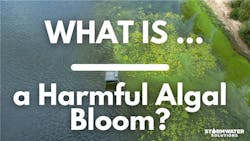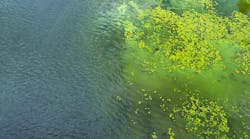Key Highlights
- HABs are caused by excess nutrients, warm temperatures, and calm water conditions, often linked to runoff and pollution.
- They produce toxins harmful to aquatic life, humans, and animals, leading to fish kills, contaminated water, and health issues.
- Freshwater HABs mainly involve cyanobacteria, while marine HABs include dinoflagellates like red tide, both producing dangerous toxins.
What is a harmful algal bloom (HAB)?
A harmful algal bloom (HAB) is an excessive growth of algae that is composed of microscopic, single-celled organisms like cyanobacteria or dinoflagellates. HABs can damage ecosystems, human health and local economies.
Not all algal blooms are harmful, but some become a problem when:
- Toxins are produced: Some algae release potent natural toxins that can sicken or kill fish, shellfish, mammals, birds and people.
- Oxygen is depleted: As HABs die and decompose, they consume dissolved oxygen in the water, leading to fish kills.
- Light is blocked: Dense blooms can reduce sunlight penetration, harming aquatic plants and disrupting food webs.
- Drinking water is affected: HABs can contaminate water supplies with toxins or foul tastes and odors.
HABs can disrupt local industries, like fishing, and can decrease the supply. They can also shut down bodies of water used for recreation as they pose a health risk to wildlife and humans.
The blooms often occur when nutrient levels (nitrogen and phosphorous) are high, water is warm and conditions are calm. These combinations can be linked to agricultural runoff, wastewater discharges and climate change.
Nutrient loading from runoff
Stormwater can carry nitrogen and phosphorous from fertilizers, pet waste, yard debris, eroded soils and atmospheric deposition. When these nutrients enter receiving waters, they “feed” algae and can accelerate or trigger blooms.
In urban areas, stormwater washes pollutants off impervious surfaces like streets, rooftops and parking lots, directly into waterways.
In agricultural areas, stormwater washes excess fertilizer and manure from fields into ditches, streams and lakes.
What causes harmful algal blooms?
HABs can be caused by several things, including a combination of biological, chemical and environmental factors that allow certain algae to grow excessively. The main causes include:
- Nutrient enrichment: Excessive nitrogen and phosphorous
- Warm water temperatures: HABs thrive in warmer waters
- Stagnant or slow-moving water: Calm conditions allow algae to grow
- Light availability: Shallow, clear water with ample sunlight accelerates growth
- Hydrologic changes: Altered flows can reduce flushing rates
- Biological interactions: Some algae produce toxins as a competitive advantage
What are the most harmful algal blooms?
HABs can be broken down into two subcategories: Freshwater and marine systems.
Freshwater HABs
Freshwater HABs mostly consists of cyanobacteria or blue-green algae. These are the primary concerns for drinking water utilities, stormwater ponds and lakes. Freshwater HABs includes:
- Microcystis: Produces potent liver toxins
- Anabaena/Dolichospermum: Can produce anatoxins and saxitoxins
- Aphanizomenon: Produces neurotoxins and hepatotoxins
- Cylindrospermopsis: Produces a toxin that can damage the liver and kidneys
Marine HABs
Marine HABs mostly consists of dinoflagellates and diatoms. These are critical for coastal waters, seafood safety and fisheries. Marine HABs includes:
- Karenia brevis: Also known as “red tide,” it can produce brevetoxins that kill fish
- Alexandrium: Produces saxitoxins
- Pseudo-nitzschia: Produces domoic acid
- Dinophysis: Produces okadaic acid
Is algae bloom harmful to humans?
Some algal blooms are harmful to humans, but not all. The danger depends on the species of algae/cyanobacteria and whether they produce toxins.
Many blooms are dense accumulations of algae that discolor the water and, while they look unpleasant, don’t necessarily pose health risks.
Algal blooms are harmful when toxins reach drinking water and when there is exposure during recreational activities like swimming, boating or fishing. Certain cyanobacteria in freshwater can release toxins that cause liver damage, neurological symptoms or gastrointestinal illness. Marine HABs can contaminate shellfish and fish with toxins that, if ingested, can cause paralytic, diarrhetic or amnesic shellfish poisoning.
About the Author
Alex Cossin
Associate Editor
Alex Cossin is the associate editor for Waterworld Magazine, Wastewater Digest and Stormwater Solutions, which compose the Endeavor Business Media Water Group. Cossin graduated from Kent State University in 2018 with a Bachelor of Science in Journalism. Cossin can be reached at [email protected].




